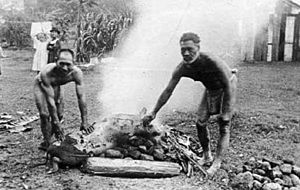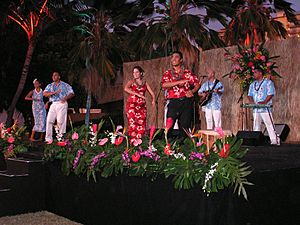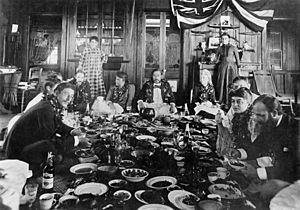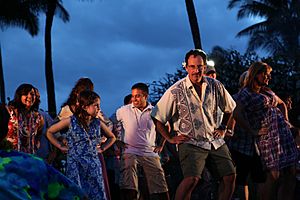Lūʻau facts for kids

A lūʻau is a special Hawaiian party or feast. It often includes delicious food and fun entertainment. You might find foods like kālua puaʻa (roasted pig), poi, and haupia (a coconut pudding). Entertainment usually features traditional Hawaiian music and hula dancing. In Hawaiʻi, a lūʻau is a common way to celebrate many events. These can be graduations, weddings, baby arrivals, or birthdays.
The History of Lūʻau Parties
Long ago in ancient Hawaiʻi, men and women ate their meals separately. Also, women and most people were not allowed to eat certain special foods. These foods were usually saved for important occasions.
However, in 1819, King Kamehameha II changed these old rules. He ended the Hawaiian religious kapu (taboo) system. He did this by eating a meal with women. This important act led to the creation of the lūʻau parties we know today.
Delicious Lūʻau Foods
In the past, these feasts were called pāʻina or ʻahaʻaina. The name "lūʻau" comes from a dish often served at these parties. This dish is called squid or chicken lūʻau. It is made with meat, lūʻau (or taro) leaves, and coconut milk.
The most important dish at a lūʻau is kālua puaʻa. This is a whole pig slow-cooked in an imu, which is an underground oven. Another common food is poi, made from the roots of the taro plant.
Traditionally, lūʻau meals were served on mats on the floor. These mats were often decorated with large centerpieces made from tī leaves. People did not use forks or spoons. All the food was eaten by hand. For example, different types of poi were known by how many fingers you needed to eat them. There was "three-finger," "two-finger," or the thickest, "one-finger poi."
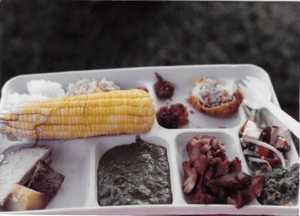
A traditional lūʻau often includes foods like:
- Chicken long rice
- Haupia (coconut pudding)
- ʻUala (Hawaiian sweet potato)
- Hawaiian sweet bread
- Kālua puaʻa (Hawaiian roast pig)
- Kulolo (taro and coconut dessert)
- Laulau (meat and fish wrapped in taro leaves)
- Lomilomi salmon (massaged salmon salad)
- Poi (taro paste)
- Poke (diced raw fish salad)
- Squid lūʻau or chicken lūʻau (meat with taro leaves and coconut milk)
- Tropical fruits
Lūʻau-Themed Parties
Lūʻau-themed parties are popular even outside of Hawaiʻi. Some parties try to be very traditional, even bringing food from the islands. Others are more relaxed, using artificial lei and serving drinks like maitais by a pool.
To host a lūʻau-themed party, it's good to have an open outdoor space. Lūʻau are often held under large tents. A lei is a very common item at these parties. A lei is a necklace made of flowers, ferns, or kukui nuts. Guests can make their own lei or buy them.
Entertainment is a must at these parties. Instruments like the ukulele, guitar, and drums are often played. You will also often see hula dancers performing.
Donn Beach helped make lūʻaus popular in the United States. A 1946 Life magazine article showed one of his famous lūʻaus in California. He helped turn private lūʻaus into bigger public events. He even included famous singers like Alfred Apaka in his parties.
See also
 In Spanish: Fiesta luau para niños
In Spanish: Fiesta luau para niños


